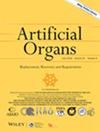Iodinated Contrast Adsorption in Cartridges With Styrene-Divinylbenzene Sorbent
Abstract
Background
Contrast-associated acute kidney injury (CA-AKI) is frequent in patients with chronic kidney disease who are submitted to cardiac endovascular procedures using iodinated contrast. In hemoadsorption, cartridges containing styrene-divinylbenzene sorbent resin are applied to remove substances from the blood through an extracorporeal circuit. Importantly, iodinated contrast is also removed via adsorption. We aimed to determine the adsorptive kinetics of the iodinated contrast medium iohexol using a 1:3 scale model of the HA380 cartridge.
Methods
An experimental in vitro study utilizing a closed-loop extracorporeal circuit with an interposed sorbent cartridge. A solution spiked with iohexol was recirculated for 60 min. Samples for the measurement of iohexol were drawn at 0, 5, 10, 15, 20, 30, 40, and 60 min. The experiment was carried out twice.
Results
In experiments 1 and 2, the reduction ratio after 60 min was 53.0% and 53.1%, respectively. In experiment 1, iohexol clearance was 46.79 mL/min during the first 5 min and decayed to 3.57 mL/min during the last 20 min. In experiment 2, iohexol clearance was 46.72 mL/min and decayed to 3.87 mL/min during the last 20 min. The ratio of adsorbate/sorbent was 155 mg/g.
Conclusion
A 1:3 scale model of the HA380 cartridge efficiently removes iodinated contrast in a clinical-scale in vitro circuit. These findings provide a rationale for hemoadsorption as an intervention in clinical trials to prevent or attenuate CA-AKI.


 求助内容:
求助内容: 应助结果提醒方式:
应助结果提醒方式:


